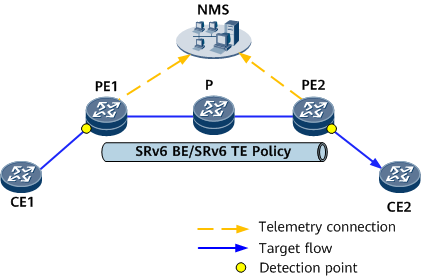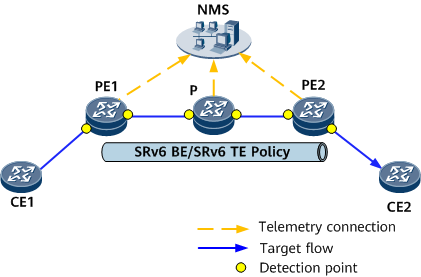iFIT Applications in a Scenario Where Public Network Traffic Enters an SRv6 Tunnel
In a scenario where public network traffic enters an SRv6 tunnel, you can configure iFIT measurement points, in E2E or hop-by-hop mode, to monitor network performance. You can deploy iFIT in such a scenario as follows:
- Deploy public network services over SRv6, and import public network traffic to the ingress.
- Configure the ingress as an iFIT measurement point from which the measurement starts.
- Set other measurement points based on the statistics collection mode.
- E2E statistics collection: Only the egress is configured as the iFIT measurement point to collect performance statistics.
- Hop-by-hop measurement: iFIT measurement points are configured on each node that traffic passes through to collect performance statistics.
- Each measurement point reports the statistics to the NMS. Users can view the statistics on the GUI.
Figure 1 shows the typical networking of iFIT E2E performance measurement in a scenario where public network traffic enters an SRv6 tunnel. iFIT measurement points are deployed on the ingress and egress of the public network traffic to monitor network performance in real time.

Figure 2 shows the typical networking of iFIT hop-by-hop performance measurement in a scenario where public network traffic enters an SRv6 tunnel. iFIT measurement points are deployed on nodes through which the public network traffic passes to monitor network performance in real time.

After iFIT is deployed, it measures the packet loss and delay of public network service packets entering the SRv6 tunnel in real time. This allows customers to promptly adjust services when network performance deteriorates.
Service Type |
Tunnel Type |
Measurement Granularity |
|---|---|---|
IPv4 public network |
SRv6 (SRv6 BE/SRv6 TE Policy) |
Measurement based on 5-tuple and DSCP or based on peer locator |
IPv6 public network |
SRv6 (SRv6 BE/SRv6 TE Policy) |
Measurement based on 5-tuple and DSCP or based on peer locator |

Currently, iFIT is not supported in the public network over MPLS tunnel scenarios.